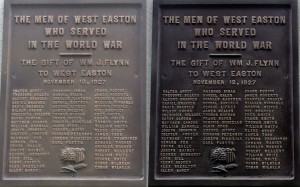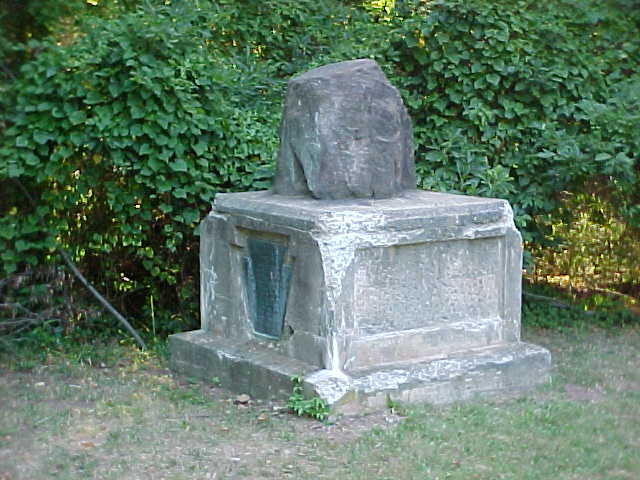After writing the previous post about the WWI plaque on our monument and posting a picture of it, I was bothered by how weathered it appeared and had lost its shine. Hardly in the condition of the Mount Gretna, PA WWI plaque in the picture above, I still wanted to make it more presentable, as it approaches its 90th year in existence.
I called around looking for somebody that does restoration work and they wanted an arm and a leg to clean it. I mentioned this to a friend and he said he knew somebody that might be able to give me some advice. I was talking to him less than an hour later.
He told me that people are far too aggressive when cleaning plaques and monuments.
Never use a pressure washer, or chemicals that you would use around the house. These can destroy the protective coating on a plaque, and in the case of stone, chemicals soak into the stone and cause damage. Bleach and salt based cleaners are the worst possible things to use for cleaning these tributes, he said.
Normally, just a tablespoon of Dawn liquid detergent in a gallon of water with a soft brush is all you need. If there is growth on the stone, such as lichens, a biocide cleaner can be used.
Tap water can be used when cleaning, but the area must be thoroughly rinsed with distilled water, as stone can stain with repeated washings using tap water. Distilled water has a desired pH of between 7.5 and 9, the normal levels of pH found in most monument stone.
Soapy water, a lot of elbow grease, and a good rinse is all most plaques and monuments require, he assured me. I also got a lesson on replacing the protective coating that keeps bronze plaques from turning green. The coating is usually lost over time from weather and UV rays from the sun.
I told him the plaque I was looking at was donated in 1927. “The protection is probably gone. Give it a good wax job and buff,” he said. “Nuetral KIWI shoe polish will do the job, if you can’t find anything with UV protective additives, made specifically for plaques” he added.
So, today I went to work, stepping on a narrow ledge near the bottom of the monument, hugging it with one arm, and doing a balancing act that I’m sure gave the cars driving by a good laugh. I scrubbed with a soft brush using my free hand.
I scrubbed, rinsed, and scrubbed some more. Then I scrubbed again. 90 minutes later I finally finished rinsing the whole thing down with 2 gallons of distilled water I had waiting.
I soaked up the excess water with a cotton cloth, then used compressed air to make sure it was totally dry.
Then I applied the wax with a soft paint brush and buffed with a shoe brush. I did this twice.
It may not be in pristine condition, but I’m sure it is much closer to how it originally appeared when it was presented in 1927.

Disclaimer: On January 4, 2016, the owner of WestEastonPA.com began serving on the West Easton Council following an election. Postings and all content found on this website are the opinions of Matthew A. Dees and may not necessarily represent the opinion of the governing body for The Borough of West Easton.







